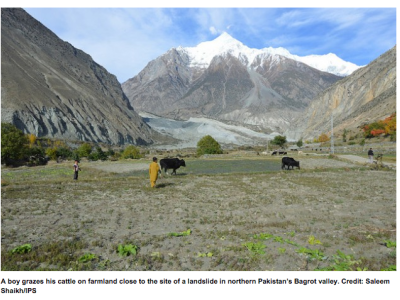Pakistan’s Mountain Communities Look to Climate Adaptation

GLACIER LAKE OUTBURST FLOOD(GLOF) is one of the most dangerous consequences of climate change in the mountain regions. Rapidly melting glaciers form lakes as they retreat, where the water is held back by naturally formed moraine or ice dams. When the ice or sediments that contain the lakes breach suddenly, a dangerous flood will follows.
These lake outbursts can cause catastrophic flooding downstream, with serious damage to life, forests, property, farms, and infrastructure. In a V-shaped canyon, the flood takes form of an extremely fast-moving torrent; in a floodplain, the flood can deluge an entire village. Home to over 10,000 people, the Bagrote Valley is under constant threat of GLOFs.
The Government of Pakistan and UN Development Programme, with financing from the Kyoto Protocol’s Adaptation Fund are providing communities in Bagrote Valley with assistance to implement measures to reduce their risks to GLOF hazards and other climate-induced disasters. Since 2012, the assistance provided has focused on three main fronts:
1. Implementation of a)early warning measures to warn communities of impending flooding as a result of rapidly melting glaciers and b)risk-reduction adaptation infrastructure;
2. Raise awareness and inform the public about the risks posed by rapidly melting glaciers;
3. Develop policy recommendations and strengthen public sector institutional capacity to manage climate change induced GLOFs if/when they do occur;
Read our photo story HERE.
Read about our story written by Inter Press Service HERE.
